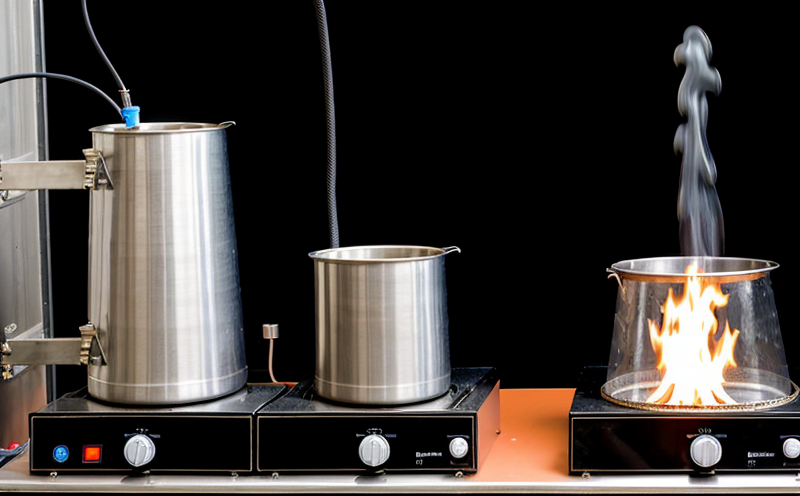Heat Release Testing of Packaging Materials
The importance of heat release testing in packaging materials cannot be overstated. As quality managers and compliance officers strive to ensure product safety and sustainability across various sectors, understanding the heat release behavior of packaging is crucial. Heat release testing evaluates how a material behaves when exposed to thermal sources such as flames or high temperatures, providing critical data on flammability, flame spread rate, and smoke generation.
In many industries, including aerospace, automotive, and consumer goods, heat release testing plays a vital role in ensuring that packaging materials meet stringent safety standards. This service is particularly important for the design of fire-safe products that can prevent the propagation of fires and protect human life and property. Compliance officers rely on this information to ensure their products are compliant with relevant international standards such as ASTM E648, ISO 56601, and EN 30-1.
The testing process involves subjecting a sample to controlled heating conditions in a calorimeter or other similar apparatus. The apparatus measures the heat release rate (HRR) over time, providing insights into the material's flammability characteristics. This data is then used to assess whether the packaging meets the required fire safety standards.
For R&D engineers and procurement professionals, this service offers a valuable tool in optimizing materials for improved performance. By understanding how different materials behave under heat release testing, they can make informed decisions about material selection and design improvements that enhance both safety and sustainability. The insights gained from such tests are essential for developing safer products with reduced environmental impact.
Moreover, the results of heat release testing contribute to a broader effort towards sustainable development goals by promoting the use of materials that reduce fire risks while minimizing adverse effects on the environment. This service supports businesses in achieving their sustainability targets and complying with regulatory requirements related to fire safety.
Why It Matters
The outcomes of heat release testing are not just numbers; they represent real-world implications for public safety, product performance, and environmental impact. In the aerospace sector, for instance, materials used in aircraft interiors must be highly resistant to fire due to the enclosed nature of cabins and the potential risk of rapid fire spread. Failure to meet these stringent requirements can lead to catastrophic incidents.
In the automotive industry, packaging that comes into contact with fuel or other flammable substances must also demonstrate exceptional flame resistance. Non-compliance can result in accidents not only during transport but also at manufacturing sites where such materials are handled.
For consumer goods manufacturers, ensuring that their packaging does not pose a fire hazard is essential for protecting the end-users and minimizing recalls. The data from heat release testing helps in designing safer products that comply with international regulations like ISO 56601:2020 and EN 30-1.
From an environmental standpoint, materials with low smoke and gas emissions contribute positively to air quality and reduce the risk of respiratory problems. This aligns with broader sustainability goals aimed at reducing pollutants and enhancing public health. The insights gained from this testing can lead to innovations that not only improve safety but also minimize harm to the environment.
Heat release testing is a cornerstone in maintaining high standards of product integrity and consumer confidence, ensuring that materials used in packaging do not compromise on fire safety or sustainability.
Environmental and Sustainability Contributions
The environmental impact of heat release testing extends beyond immediate fire safety concerns to encompass broader sustainability goals. By focusing on reducing the flammability and smoke generation of packaging, businesses can contribute significantly to minimizing the carbon footprint associated with waste management.
When materials used in packaging burn incompletely or generate excessive smoke, they not only pose a risk during fires but also release harmful chemicals into the atmosphere when disposed of improperly. This contributes to air pollution and exacerbates climate change issues. The data from heat release testing helps identify materials that are more sustainable by reducing these adverse effects.
Additionally, by promoting the use of fire-safe packaging, businesses can reduce the likelihood of fires in landfills or during transportation, which could otherwise lead to further environmental degradation. Sustainable packaging designs contribute to a circular economy by enabling easier recycling and reduced waste generation.
The insights from heat release testing also guide manufacturers towards selecting materials that are inherently more sustainable, such as those with lower life cycle impacts or those that can be recycled more efficiently without losing their performance characteristics. This aligns with the growing trend of adopting green practices across industries to meet global sustainability targets.
Use Cases and Application Examples
- Aerospace Industry: Testing materials used in aircraft interiors, such as fabrics and insulation, to ensure they comply with stringent fire safety standards like ASTM E648 and EN 30-1.
- Automotive Sector: Evaluating packaging materials that come into contact with fuel or other flammable substances to prevent accidents during transport and manufacturing.
- Consumer Goods Manufacturer: Ensuring that the chosen packaging does not pose a fire hazard, thereby protecting end-users from potential risks and complying with international regulations like ISO 56601:2020.
- Sustainable Packaging Development: Identifying materials with low smoke and gas emissions to enhance air quality and contribute positively to public health and environmental goals.
- R&D Engineers: Optimizing material selection for improved performance in terms of flammability, flame spread rate, and smoke generation to meet fire safety standards.
- Procurement Professionals: Making informed decisions about material sourcing that enhance both safety and sustainability in product design.





